French Recipes for Soups
“Indeed, stock is everything in cooking [...] without it, nothing can be done.”
- Auguste Escoffier
French Soup Culture
In French cuisine, soups are often served as a starter (entrée) to stimulate the appetite or as a light meal on their own. Whether it's the hearty rusticity of garbure or the delicate refinement of consommé, soups are integral to French culinary traditions, celebrating both the seasons and regional specialties.
French cuisine has a long tradition of delicious and diverse soups, ranging from hearty, rustic varieties to refined and delicate creations. Here are some of the most iconic and classic French soups:
Classic French Soups
Some French soups have achieved international fame, becoming iconic dishes in their own right:

Potage (Thick Soups)
Potage Parmentier: A simple and beloved soup made from potatoes and leeks, named after Antoine-Augustin Parmentier, who promoted the consumption of potatoes in France. It's rich, creamy, and perfect for colder weather.
Crème Dubarry: A velvety cauliflower soup that's thickened with cream, showcasing the French penchant for smooth, elegant soups.
Garbure: A hearty, rustic soup from the southwest of France, made with cabbage, beans, potatoes, and often duck confit or ham. It's a peasant dish with origins in Gascony and Béarn, traditionally slow-cooked to allow the flavors to deepen.
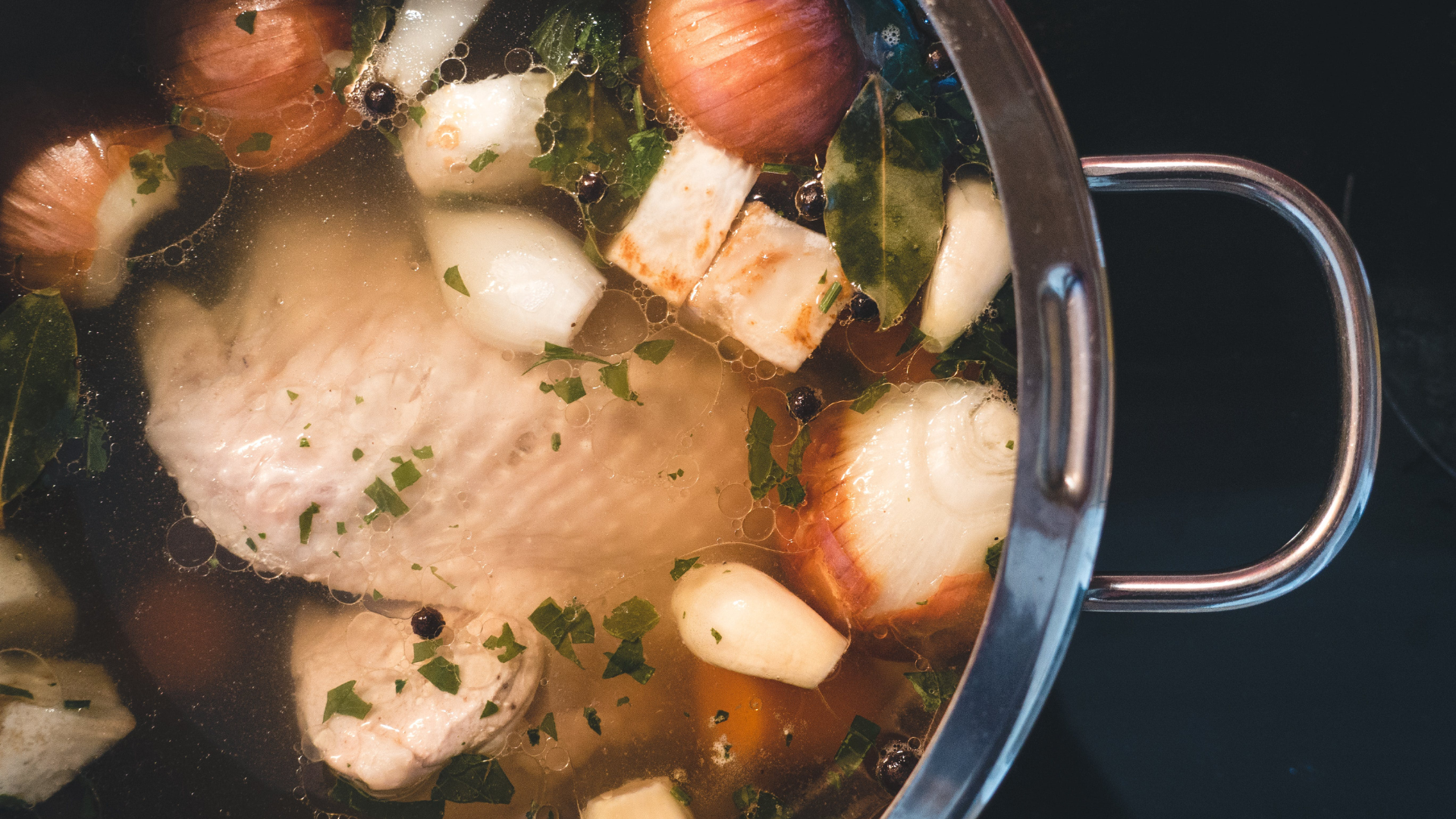
Bouillon (Broths)
Bouillon refers to a clear, seasoned broth made from simmering meat, fish, or vegetables. It's often the base for other soups or dishes.
Bouillon de Poule (Chicken Broth): A simple chicken broth, often used as the base for many other French soups and stews. It's nourishing and commonly used as a cold remedy.

Consommé (Clear Soups)
Consommé: A highly clarified broth, often made from beef or chicken, simmered with herbs and sometimes served with tiny garnishes like vegetables or dumplings. It's elegant and served in small portions, often as a starter in formal French dining.
Consommé Célestine: A consommé garnished with thin strips of savory pancakes (crêpes), common in the Alsace region.
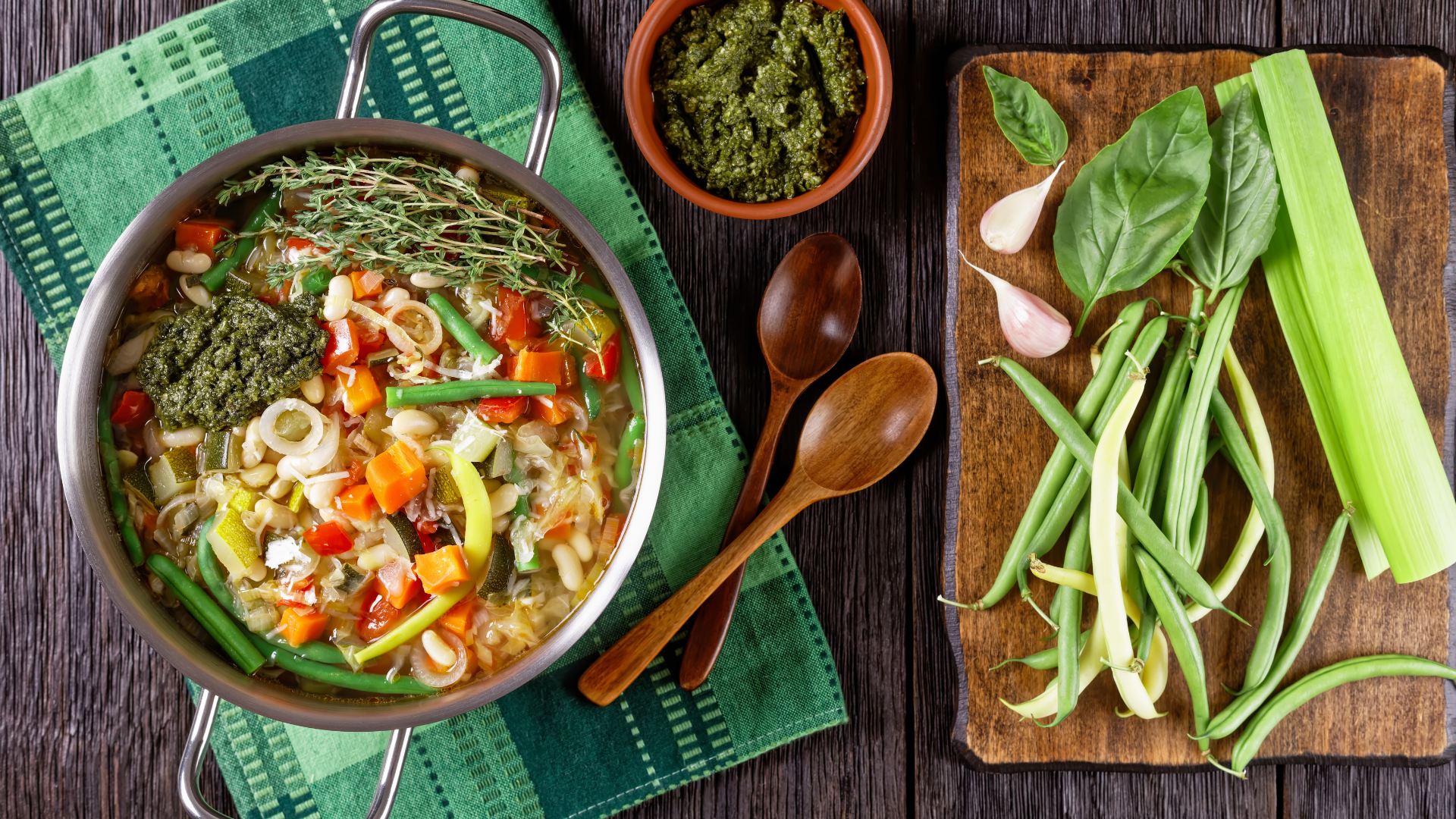
Soupe au Pistou
From the Provence region, soupe au pistou is a vegetable soup made with white beans, tomatoes, zucchini, and pasta, finished with pistou—a basil, garlic, and olive oil sauce similar to pesto. This soup is celebrated for its bright, summery flavors.
French Onion Soup (Soupe à l'Oignon)
(Soupe à l'Oignon)
French onion soup, or soupe à l'oignon, is one of France’s most iconic and beloved dishes, known for its rich flavors and comforting warmth. It traditionally consists of caramelized onions, beef broth, and a topping of melted cheese over toasted bread. This dish has rustic origins but became a staple of French cuisine, often associated with Parisian bistros and cold winter nights.
History of French Onion Soup (Soupe à l'Oignon)
Ancient Origins:
Onion soup has roots that stretch back to antiquity. Onions were widely available and inexpensive, making them a staple for many ancient civilizations, including the Romans and Greeks, who valued onions for their hardiness and believed they had medicinal properties. In medieval times, onion-based soups were common across Europe and considered food for the poor due to the easy availability and low cost of onions.
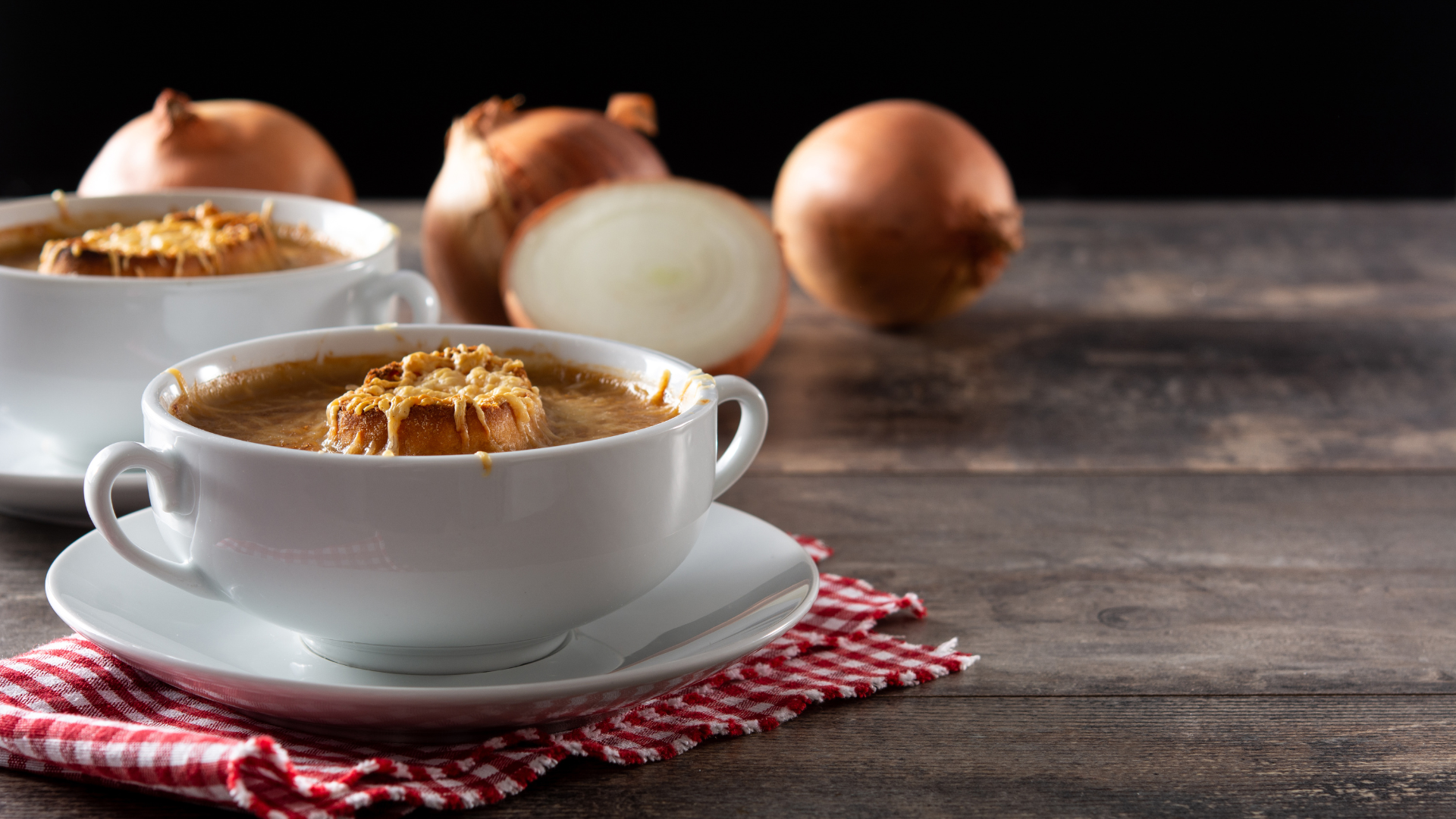
19th Century and the Rise of French Gastronomy:
During the 19th century, the dish became a favorite among the late-night crowds of Paris, especially at the famous market of Les Halles, which was known for feeding merchants, workers, and night owls. Soupe à l'oignon gratinée (the version with melted cheese and bread) was particularly beloved as a cure for hangovers after long evenings of revelry. It was also around this time that the dish began to appear in bistros and restaurants, becoming a mainstay of French cuisine.
Renowned chef Auguste Escoffier, considered one of the founding figures of modern French cuisine, further elevated the dish. His refinement of French onion soup helped solidify it as a brasserie classic. By then, the combination of deeply caramelized onions, rich broth, and the gratin topping made it a favorite among all social classes.
Global Popularity:
In the 20th century, particularly after World War II, French cuisine gained international recognition, and French onion soup became a symbol of French culinary tradition worldwide. The soup was brought to the U.S. by returning soldiers, and by the 1960s, it was a fashionable dish in American restaurants, associated with the rise of French fine dining.
Modern Day:
Today, French onion soup is not only a popular bistro dish but also a favorite comfort food prepared at home. It continues to represent the heart of French cuisine: a dish that combines simple, rustic ingredients with the refinement of technique, producing a result that is rich, warming, and deeply satisfying.
It is still often served in traditional French restaurants and is a popular choice in winter menus across the world. While variations exist, the classic recipe remains a beloved part of France’s culinary heritage.
French Refinement:
Though its origins are humble, the version of onion soup we recognize today was refined in 18th-century France. It gained popularity among the working class and was often sold by street vendors around Les Halles, the central market in Paris. The transformation of this rustic dish into a culinary classic is often attributed to the addition of beef broth and gratinée (cheesy bread), which elevated the soup from a basic meal to something heartier and more indulgent.
There is a popular legend that King Louis XV invented French onion soup by accident. The story goes that one evening, while hunting at his lodge, the King found his pantry nearly empty, containing only onions, butter, and champagne. He improvised, creating a simple onion soup that became a royal favorite. While charming, this tale is likely apocryphal.

-
Ingredients:
6 large yellow onions (thinly sliced)
4 tbsp unsalted butter
1 tbsp olive oil
2 cloves garlic (minced)
1 tbsp all-purpose flour (optional, for thickening)
1 tsp sugar (optional, to help with caramelization)
1/2 cup dry white wine (or dry sherry)
1.5 liters beef broth (or a mix of beef and chicken broth)
2 sprigs thyme (or 1 tsp dried thyme)
1 bay leaf
Salt and freshly ground black pepper to taste
1 baguette (sliced into rounds)
2 cups Gruyère or Comté cheese (grated)
1/2 cup Parmesan cheese (optional)
Instructions:
Caramelize the onions:
In a large, heavy-bottomed pot, melt the butter and olive oil over medium heat. Add the sliced onions and cook slowly, stirring occasionally, for about 25–30 minutes. The onions should turn a deep golden brown, but not burn.
You can sprinkle the sugar on the onions to enhance the caramelization process, but it's optional. Be patient, as this step is key to developing the soup’s flavor.
Deglaze the pot:
Once the onions are deeply caramelized, add the minced garlic and cook for another minute.
Sprinkle the flour (if using) over the onions and stir well for 1–2 minutes to remove the raw flour taste. This step thickens the soup slightly.
Pour in the white wine and stir to deglaze the pan, scraping up any browned bits stuck to the bottom. Let the wine simmer for 2–3 minutes.
Add broth and simmer:
Add the beef broth, thyme, and bay leaf to the pot. Bring the soup to a boil, then reduce the heat and let it simmer gently for 30–40 minutes.
Season with salt and pepper to taste, adjusting as necessary.
Prepare the bread:
While the soup is simmering, preheat the oven to 180°C (350°F).
Arrange the baguette slices on a baking sheet and toast them in the oven for about 10 minutes, until golden and crispy.
Once toasted, rub the tops lightly with a clove of garlic for extra flavor.
Assemble the soup:
Ladle the hot soup into oven-safe bowls.
Place a few toasted baguette slices on top of the soup and generously sprinkle the Gruyère or Comté cheese over the bread. Add Parmesan cheese if desired for an extra cheesy crust.
Broil and serve:
Place the bowls under a broiler (or in a hot oven) until the cheese is melted, bubbly, and golden brown—about 3–5 minutes.
Carefully remove the bowls from the oven and serve immediately, garnished with a little extra thyme if desired.
Beef Soup
The finest soup is crafted from lean, high-quality fresh beef. A recommended ratio is four pounds of meat to one gallon of water, and it should be simmered for a minimum of six hours. You can prepare mutton soup in the same way.
Start by placing the meat in cold water with a pinch of salt. Set it over a strong fire, allowing it to boil slowly and steadily while skimming off any fat that rises to the surface. Once the fat has been removed, add your desired amount of chopped carrots, turnips, leeks, celery, and parsley. For added flavor, consider including a bay leaf, a couple of peach leaves, a few cloves, and a large charred onion to enhance the soup's color.
Grate a large red carrot and stew it on top. Allow the soup to continue boiling gently, ensuring it is ready by dinner time. Besides the quantity and quality of the meat, maintaining a moderate heat is crucial for a superb soup; it should boil continuously but not too rapidly.
Prepare some toasted bread, cut into small squares, in the tureen. Strain the soup through a sieve before pouring it over the bread, though some people prefer to serve it with all the vegetables included.
The flavor of the soup will be enriched by adding the remnants of a piece of cold roast beef. Soups made from veal or chicken are typically more suitable for those who are unwell. After straining out the vegetables, you can also add some vermicelli (about two ounces per quart) and let it boil for an additional ten minutes.
Consommé
Consommé, or Jelly Soup
Into two quarts of cold water, place four pounds of the lean from the finest beef steaks and a large fowl cut into pieces. Add four large carrots, four onions, and four leeks, along with a bouquet of sweet herbs, which should include parsley, thyme, sweet marjoram, sweet basil, and chives, all tied together with a laurel leaf or two peach leaves. Don’t forget to include four cloves, along with a pinch of salt and pepper for seasoning.
Bring the mixture to a gentle boil and allow it to simmer for eight hours, ensuring to skim off any impurities that rise to the surface. Once the cooking time is complete, strain the liquid to separate it from the solids, resulting in a flavorful broth suitable for various culinary applications.
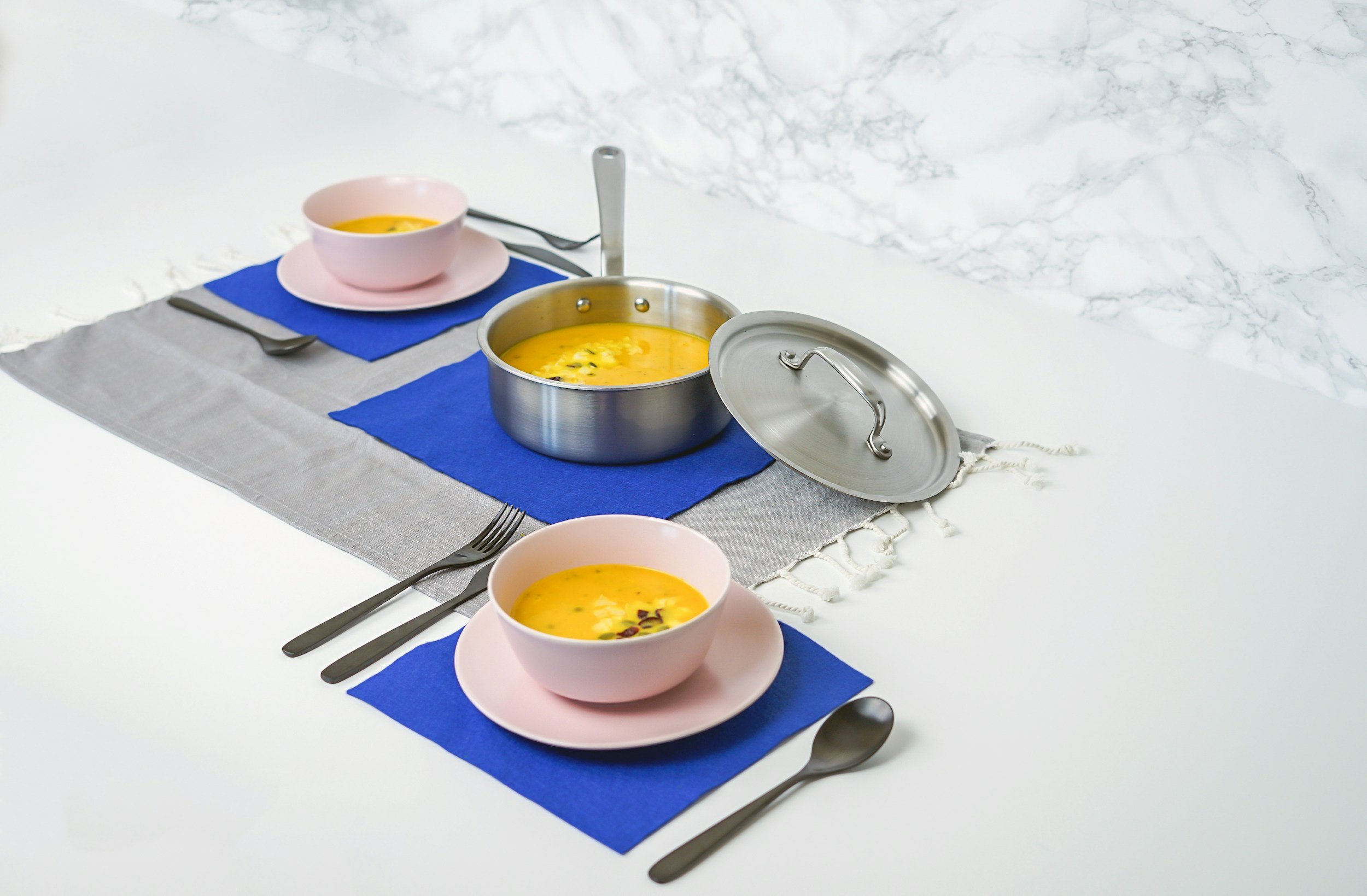
-
Ingredients:
1 lb lean ground beef
6 cups beef stock or broth
2 egg whites
1 onion, finely chopped
1 carrot, finely chopped
1 celery stalk, finely chopped
2 bay leaves
4-5 black peppercorns
Salt to taste
Fresh herbs for garnish (optional)
Instructions:
Prepare the Clarifying Mixture:
In a bowl, mix the ground beef, egg whites, chopped onion, carrot, and celery. This mixture will help clarify the consommé.
Combine and Heat:
In a large pot, add the beef stock and the clarifying mixture. Stir gently to combine.
Place the pot over medium heat and slowly bring the mixture to a simmer. Stir occasionally as the liquid begins to heat up.
Simmer and Clarify:
As the consommé simmers, a "raft" (a mixture of solid ingredients) will form on the surface. This raft will trap impurities, making the consommé clear. Do not stir once the raft forms.
Add bay leaves and peppercorns, and simmer gently for about 45 minutes to an hour.
Strain:
Carefully ladle the consommé through a fine sieve lined with cheesecloth to remove the solids, leaving a clear broth.
Season and Serve:
Season with salt and garnish with fresh herbs if desired. Serve hot.Description text goes here
-
Ingredients:
1 lb ground chicken (or use minced chicken breast)
6 cups chicken stock
2 egg whites
1 onion, finely chopped
1 carrot, finely chopped
1 celery stalk, finely chopped
1 bay leaf
4-5 black peppercorns
Salt to taste
Fresh parsley for garnish
Instructions:
Prepare the Clarifying Mixture:
In a bowl, combine the ground chicken, egg whites, chopped onion, carrot, and celery.
Combine and Heat:
In a pot, pour the chicken stock and add the clarifying mixture. Stir to mix.
Heat slowly over medium heat, stirring occasionally.
Simmer and Clarify:
As it simmers, a raft will form. Add the bay leaf and peppercorns, and simmer gently for about 45 minutes, allowing the consommé to clarify.
Strain:
Carefully strain the consommé through a fine sieve lined with cheesecloth to remove all solids.
Season and Serve:
Season with salt and serve hot, garnished with fresh parsley.
Peas Soup
Take two quarts of dried split peas, the evening before you intend to make the soup, and put them into lukewarm water, let them soak all night. In the morning, put the peas into a pan or pot with three quarts of cold water, a pound of bacon, and a pound of lean fresh beef.
Cut up two carrots, two onions, and two heads of celery, and put them into the soup, with a bunch of sweet herbs, and three or four cloves. Boil it slowly for five or six hours, till the peas can no longer be distinguished, having lost all shape and form; then strain it, and serve it.
Pea cream soup is a comforting and simple dish, often made with fresh or frozen peas, broth, cream, and seasonings. Pea-based soups have a long history, with variations in many cuisines worldwide. In medieval Europe, dried peas made hearty, rustic soups. Over time, as cooking techniques evolved and cream became more accessible, creamy pea soup emerged, especially in French and British cuisine.

-
Ingredients:
2 carrots, finely chopped
1 onion, finely chopped
1 leek (white part only), finely chopped
1 celery stalk, finely chopped
2 tomatoes, finely chopped
1 egg white
6 cups vegetable stock
2 bay leaves
4-5 black peppercorns
Salt to taste
Fresh herbs for garnish (e.g., thyme, parsley)
Instructions:
Prepare the Clarifying Mixture:
In a bowl, mix the chopped vegetables with the egg white. The egg white will help clarify the vegetable consommé.
Combine and Heat:
In a large pot, pour in the vegetable stock and add the clarifying vegetable mixture.
Heat slowly over medium heat, stirring occasionally until a raft begins to form.
Simmer and Clarify:
As the consommé simmers, the raft will trap impurities. Add the bay leaves and peppercorns, and simmer for about 30-40 minutes.
Strain:
Strain the consommé through a fine sieve lined with cheesecloth to achieve a clear broth.
Season and Serve:
Season with salt, and serve hot, garnished with fresh herbs.
-
French Pea Soup (Potage Saint-Germain) is a classic, smooth, and flavorful soup made primarily from green peas, often with onions, leeks, and stock, and finished with cream. Here's a traditional recipe for this delicious soup:
Ingredients:
2 tablespoons butter
1 large onion, finely chopped
1 leek, white part only, sliced
1 clove garlic, minced
4 cups green peas (fresh or frozen)
4 cups vegetable or chicken stock
1 bay leaf
1 sprig of thyme (optional)
½ cup heavy cream (optional)
Salt and pepper, to taste
Fresh herbs for garnish (such as parsley or mint)
Croutons or crusty bread, for serving
Instructions:
Sauté the Vegetables:
In a large pot, melt the butter over medium heat. Add the chopped onion, leek, and garlic. Sauté until the vegetables are soft and translucent, about 5-7 minutes.
Add the Peas and Stock:
Stir in the peas, followed by the vegetable or chicken stock. Add the bay leaf and thyme (if using). Bring the mixture to a boil, then reduce the heat and let it simmer for 10-15 minutes, until the peas are tender.
Blend the Soup:
Remove the bay leaf and thyme sprig. Use an immersion blender to purée the soup until smooth. Alternatively, transfer the soup in batches to a blender and blend until smooth.
Add Cream (Optional):
For a richer, creamier texture, stir in the heavy cream. Reheat the soup gently over low heat if necessary, but do not boil.
Season and Serve:
Taste the soup and season with salt and pepper to your preference.
Ladle the soup into bowls, and garnish with fresh herbs like parsley or mint. Serve with croutons or crusty bread on the side.
This French Pea Soup is comforting and elegant, perfect for a light lunch or as a starter for dinner. The combination of sweet peas, creamy texture, and fresh herbs makes it a delightful, satisfying dish.
Macaroni Soup
(Soupe aux Macaronis)
French Macaroni Soup, or Soupe aux Macaronis, is a humble, rustic soup that combines the versatility of pasta with the comforting qualities of a broth-based dish. Though macaroni is often associated with Italian cuisine, its use in French cooking has a long history, particularly in soups and gratins. This soup reflects both the historical influence of Italian ingredients in French kitchens and the French preference for simple, hearty meals.
Begin by preparing a flavorful beef soup, omitting any vegetables. Once it has boiled sufficiently, strain it through a sieve. Next, take half a pound of macaroni for every two quarts of soup. Cook the macaroni in water until it's tender, adding a bit of butter for flavor. Drain it using a sieve and then cut it into small pieces. Incorporate the macaroni into the soup, allowing it to boil together for at least ten minutes. Just before serving, grate some rich cheese on top for added richness.

-
French Macaroni Soup is a simple yet elegant dish, combining pasta, broth, and sometimes vegetables or cream for a rich and comforting meal. Here’s a classic recipe for this soup:
Ingredients:
1 cup macaroni (or any small pasta)
6 cups beef, chicken, or vegetable stock
1 onion, finely chopped
2 carrots, finely chopped
1 celery stalk, finely chopped
2 tablespoons butter or olive oil
½ cup cream (optional for a richer version)
Salt and pepper, to taste
Fresh parsley or chives for garnish
Grated Parmesan cheese for serving
Instructions:
Cook the Macaroni:
Bring a pot of salted water to a boil, and cook the macaroni until al dente according to package instructions. Drain and set aside.
Sauté the Vegetables:
In a large soup pot, melt the butter (or heat the olive oil) over medium heat. Add the chopped onion, carrots, and celery. Cook for 5-7 minutes, stirring occasionally, until the vegetables are soft and fragrant.
Add the Stock:
Pour in the stock, and bring the mixture to a boil. Reduce the heat to low, and let it simmer for about 15 minutes, allowing the flavors to meld together.
Combine the Macaroni:
Add the cooked macaroni to the soup, and stir to combine. If using cream, stir it in at this point and gently heat the soup without bringing it to a boil.
Season and Serve:
Season the soup with salt and pepper to taste. Ladle it into bowls, and garnish with fresh parsley or chives. Sprinkle some grated Parmesan cheese on top for added flavor.
Optional: For a more rustic version, you can add more vegetables like peas or leeks. You can also sauté some garlic along with the vegetables for added depth.
This French Macaroni Soup is a comforting, filling dish with simple, rich flavors. It’s perfect as a starter or a light meal, especially when served with crusty bread.
French Leek and Potato Soup (Potage Parmentier)
Potage Parmentier, a classic French leek and potato soup, is known for its simplicity and comforting flavor. It's named after Antoine-Augustin Parmentier, an 18th-century French agronomist who is credited with popularizing the potato in France as a nutritious and versatile food. Potage Parmentier is typically made with just a few ingredients—leeks, potatoes, butter, and stock—and is often served either hot or cold.
When served cold, it becomes Vichyssoise, a variation popularized in the 20th century.

Potage Parmentier: A Simple, Rustic Soup
Potage Parmentier became a staple of French cuisine in the 19th century, particularly in the home kitchens and bistros of Paris. The soup is a reflection of French culinary tradition, which values simplicity, quality ingredients, and minimal waste. Leeks and potatoes were (and remain) inexpensive, easily accessible ingredients, making this soup a practical and nourishing meal, especially in the colder months.
Leek and potato soups were common in rural areas of France, where families relied on hearty, inexpensive meals. Over time, the addition of broth, butter, and cream elevated this once humble dish to the level of classic French cuisine, appreciated for its elegant yet rustic flavor.

The Creation of Vichyssoise:
In the early 20th century, a cold variation of Potage Parmentier called Vichyssoise became popular, particularly in the United States. While the exact origins are debated, the cold leek and potato soup is often attributed to Louis Diat, a French chef who worked at the Ritz-Carlton Hotel in New York City in the 1910s. Diat named the dish after his hometown of Vichy, a spa town in France, and it quickly became a favorite in fine dining establishments.
In contrast to Potage Parmentier, Vichyssoise is typically blended with cream and served chilled, making it a refreshing option in the summer months.
A Timeless Classic:
Potage Parmentier continues to be a beloved dish in France and around the world, cherished for its comforting flavor, simplicity, and connection to French culinary history. Its versatility, whether served hot as a winter soup or cold as Vichyssoise, ensures its place as a classic staple in French cuisine.

-
Ingredients:
3 large leeks (white and light green parts only, cleaned and sliced)
4 medium potatoes (Yukon gold or russet, peeled and diced)
1 large onion (optional, finely chopped)
3 tbsp unsalted butter (or olive oil)
1.5 liters vegetable or chicken broth (or water)
Salt and freshly ground black pepper, to taste
1/2 cup heavy cream or milk (optional, for a richer texture)
Chopped fresh chives or parsley for garnish
Instructions:
Prepare the vegetables:
Clean the leeks thoroughly by slicing them in half lengthwise and washing between the layers to remove any dirt or sand. Slice the white and light green parts thinly. Peel and dice the potatoes into small, even pieces.
Sauté the leeks:
In a large pot, melt the butter over medium heat. Add the sliced leeks (and onions, if using) and sauté gently for 5–7 minutes, until they are softened but not browned. Stir occasionally to avoid browning.
Add the potatoes and broth:
Add the diced potatoes to the pot, followed by the broth. If using water instead of broth, season generously with salt.
Bring the mixture to a boil, then reduce the heat and let it simmer gently for 20–25 minutes, until the potatoes are tender.
Blend the soup:
Once the potatoes are fully cooked, remove the pot from the heat.
Use an immersion blender to purée the soup until smooth, or transfer the soup in batches to a blender. You can leave the soup a bit chunky if you prefer more texture.
Finish with cream (optional):
Stir in the cream or milk, if using, for a richer texture. Taste and adjust the seasoning with salt and pepper as needed.
Serve:
Ladle the soup into bowls and garnish with fresh chopped chives or parsley.
Serve with a side of crusty bread for dipping.
Seasonal and Special Occasion Soups
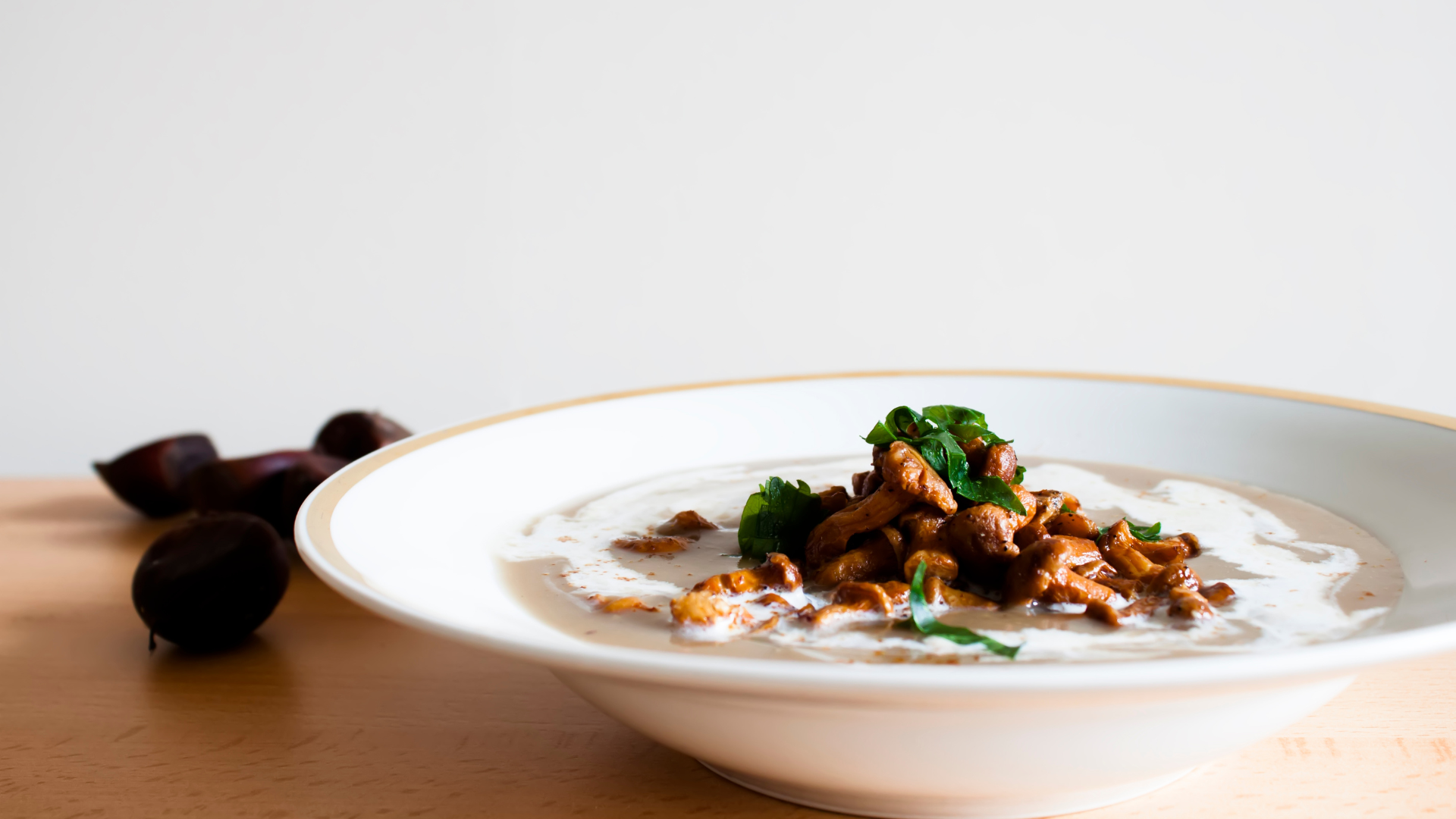
Chestnut Soup: Especially popular in the Autumn in regions like Corsica and Ardèche, chestnut soup is creamy and rich, celebrating the chestnut harvest.
Soupe de Poireaux et Morilles: A luxurious leek and morel mushroom soup, often enjoyed in the spring when morels are in season.
Chestnut Soups
After making a basic beef broth, the soup is enhanced by the addition of chestnuts, which dissolve into the liquid, creating a creamy, slightly sweet texture. The chestnuts absorb the savory broth, blending into the soup to create a smooth consistency.
Two Variations:
Raw Chestnut Method: After straining the beef soup, you add a pint of peeled chestnuts for each quart of broth. The soup is then simmered until the chestnuts have broken down completely and merged with the liquid. This method provides a more subtle integration of the chestnut flavor.
Roasted Chestnut Method: For a richer flavor, roast or bake the chestnuts first, after cutting a slit in each shell to allow steam to escape. Once roasted and peeled, the chestnuts are added to the soup about ten minutes before it is finished. This version creates a deeper, more complex taste, as the roasted chestnuts remain somewhat intact, adding texture and flavor just before serving.
Both approaches yield a warming, smooth soup, perfect for colder days. The combination of chestnuts and beef creates a satisfying, luxurious dish with a touch of sweetness from the chestnuts.

Almond Soups
Start by taking half a pound of shelled sweet almonds and two ounces of shelled bitter almonds (or peach kernels). To easily remove their skins, scald the almonds by briefly placing them in boiling water. Once scalded, the skins will loosen and can be peeled off effortlessly. After peeling, transfer the blanched almonds to cold water to stop the cooking process. This ensures they stay firm and retain their flavor.

Then drain and wipe them dry. Beat them (a few at a time) in a marble mortar, adding as you beat them, a little milk and a little grated lemon peel.
Prepare two quarts of rich milk in a pot, and bring it to a boil along with two sticks of cinnamon and a quarter of a pound of sugar. Once the milk is infused with the warm cinnamon flavor and the sugar has dissolved, gradually stir in the ground almonds. Allow the mixture to come to a gentle boil once more, letting the flavors meld together.
Toast several slices of bread until golden and crisp. Take a small portion of the soup and use it to soak the toasted bread slices, allowing them to absorb the liquid. Once soaked, place the bread at the bottom of a tureen. Pour the rest of the hot almond soup over the soaked bread in the tureen. Finish by grating some fresh nutmeg on top for a fragrant, warming touch.

-
Here’s a classic recipe for French Chestnut Soup (Potage aux Marrons), which is creamy, rich, and perfect for colder months:
Ingredients:
500 g chestnuts (fresh, cooked, or vacuum-packed)
2 tablespoons butter
1 onion, finely chopped
1 leek (white part only), finely chopped
2 garlic cloves, minced
1 carrot, chopped
1 celery stalk, chopped
1 liter chicken or vegetable stock
200 ml heavy cream
1 bay leaf
1 sprig thyme (optional)
Salt and pepper to taste
Fresh parsley or thyme for garnish
Instructions:
Prepare the Chestnuts:
If using fresh chestnuts, score a cross on the flat side of each chestnut and boil them for about 15 minutes, then peel off the outer shell and inner skin. You can skip this step if you're using pre-cooked or vacuum-packed chestnuts.
Sauté the Vegetables:
In a large pot, melt the butter over medium heat. Add the chopped onion, leek, garlic, carrot, and celery. Cook for about 5-7 minutes, stirring occasionally, until the vegetables are soft and fragrant.
Add the Chestnuts and Stock:
Add the peeled chestnuts to the pot, followed by the chicken or vegetable stock. Add the bay leaf and thyme (if using). Bring the mixture to a boil, then reduce the heat and let it simmer for 20-25 minutes, until the chestnuts are tender and easily break apart.
Blend the Soup:
Remove the bay leaf and thyme sprig. Use an immersion blender to purée the soup until smooth. Alternatively, transfer the soup in batches to a blender and blend until creamy.
Add the Cream:
Stir in the heavy cream and gently reheat the soup. Avoid boiling it after adding the cream, as it can affect the texture.
Season and Serve:
Taste the soup and season with salt and pepper. Ladle it into bowls, garnish with fresh parsley or thyme, and serve hot.
Serving Suggestions:
You can serve the soup with crusty bread, croutons, or even a drizzle of extra cream for an elegant touch.
For added flavor, sprinkle some crispy bacon bits or roasted chestnuts on top.
This French Chestnut Soup is warm, comforting, and subtly sweet, making it an excellent starter or light meal during autumn and winter.
-
Here's a classic recipe for French Almond Soup (Soupe aux Amandes), a delicate and creamy soup with a rich almond flavor, perfect for special occasions or as a unique starter.
Ingredients:
100 g (about ½ cup) blanched almonds
2 tablespoons butter
1 onion, finely chopped
2 garlic cloves, minced
1 leek (white part only), finely chopped
4 cups chicken or vegetable stock
1 cup whole milk
½ cup heavy cream
Salt and pepper, to taste
A pinch of ground nutmeg
Slivered almonds, toasted (for garnish)
Fresh parsley or chives (for garnish)
Instructions:
Blanch and Prepare the Almonds:
If using unpeeled almonds, first blanch them by placing them in boiling water for about 1-2 minutes, then drain and peel off the skins. If using pre-blanched almonds, proceed directly to the next step.
Grind the blanched almonds into a fine paste using a food processor or mortar and pestle.
Sauté the Vegetables:
In a large pot, melt the butter over medium heat. Add the chopped onion, leek, and garlic, and sauté until soft and fragrant, about 5-7 minutes.
Add the Almond Paste and Stock:
Stir in the ground almond paste and cook for another 2 minutes to release the almond flavor.
Pour in the chicken or vegetable stock, and bring the mixture to a boil. Reduce the heat and simmer gently for 15-20 minutes, allowing the flavors to meld.
Blend the Soup:
Use an immersion blender to purée the soup until smooth. Alternatively, transfer the soup in batches to a blender and blend until creamy.
Add Milk and Cream:
Stir in the whole milk and heavy cream. Heat the soup gently, but do not bring it to a boil. Season with salt, pepper, and a pinch of nutmeg.
Garnish and Serve:
Toast some slivered almonds in a dry pan until golden brown.
Ladle the soup into bowls, garnish with the toasted almonds and fresh parsley or chives.
Serving Suggestions:
Serve this almond soup with crusty bread or alongside a light salad.
For extra richness, drizzle a bit of extra cream on top before serving.
French Almond Soup is a luxurious and elegant dish with a smooth texture and a delicate nutty flavor, making it a perfect starter for a special dinner or celebration.
4o
Soups as Comfort Food
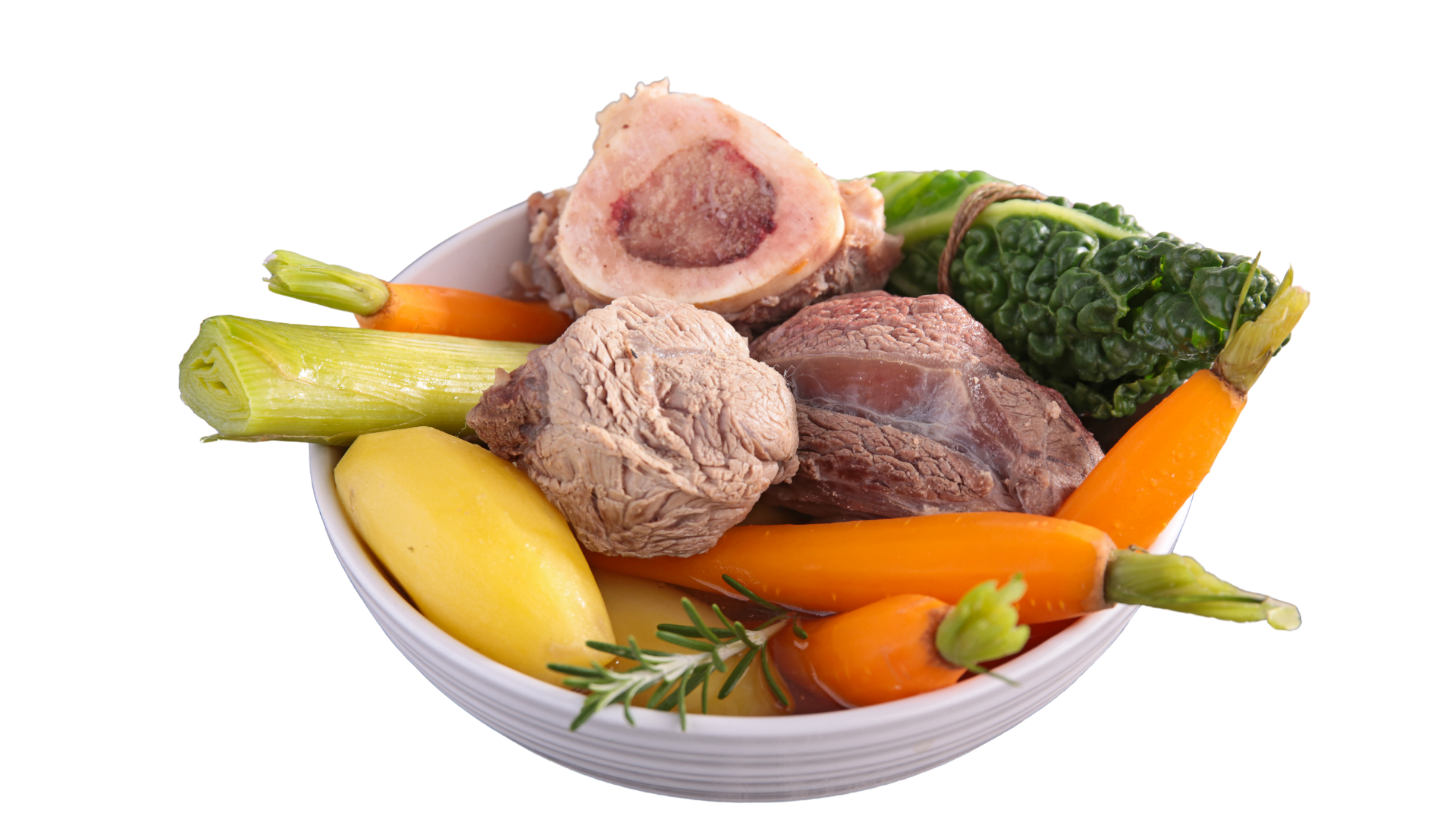
Soupe au Chou (Cabbage Soup): A traditional and hearty dish from Normandy and Alsace, made with cabbage, pork, and sometimes potatoes. It’s a rustic soup meant to warm the soul during the cold months.
Pot-au-Feu: While technically a meat and vegetable stew, it's often served as a soup in the first course. This dish is a classic example of French "comfort food," where the broth is served as a starter, followed by the meat and vegetables.
Pot-au-Feu
Pot-au-Feu is one of the most traditional and beloved dishes in French cuisine, known as the quintessential French comfort food. It translates to "pot on the fire," reflecting the dish's simplicity and rustic origins. Pot-au-Feu is essentially a boiled beef stew made with a variety of vegetables, and it has been a staple of French family meals for centuries, embodying the country’s culinary philosophy of using humble ingredients to create something deeply nourishing and flavorful.
Modern French Soup Trends

In contemporary French cuisine, chefs are innovating with soups by blending traditional flavors with modern techniques:
Velouté: A smooth, rich soup often made with pureed vegetables like pumpkin, butternut squash, or asparagus, thickened with cream or butter. Modern chefs experiment with various garnishes like truffle oil, foie gras, or even seafood.
Cold Soups: While vichyssoise is the classic cold soup, others like gazpacho (a Spanish import) and chilled tomato or cucumber soups are gaining popularity in French summer cuisine.
Velouté Soup
History of Velouté Soup
The term "velouté" comes from the French word for "velvety," a fitting description for this smooth and creamy soup. Velouté sauce is one of the five "mother sauces" of French cuisine, a foundational element introduced by chef Marie-Antoine Carême in the early 19th century. The sauce is made by thickening white stock (like chicken, veal, or fish stock) with a roux (a mixture of butter and flour). When turned into a soup, velouté embodies the essence of French culinary elegance, with its creamy, rich, and luxurious texture.
Originally, velouté soup was a simple, elegant starter in French haute cuisine. It was made from delicate ingredients, and chefs would add their own flavors depending on the season and available produce. Over time, it became a popular base for various soups, such as mushroom velouté or vegetable velouté, by incorporating puréed vegetables or other flavorings.

Variations:
Mushroom Velouté: Sauté sliced mushrooms in butter before adding them to the soup.
Vegetable Velouté: Add puréed vegetables (such as carrots, peas, or asparagus) to the soup for flavor and texture.
Chicken Velouté: Add cooked, shredded chicken for a heartier version of the soup.
Velouté soup is highly versatile, with its base offering endless possibilities for flavor customization, making it a timeless classic in French cuisine.
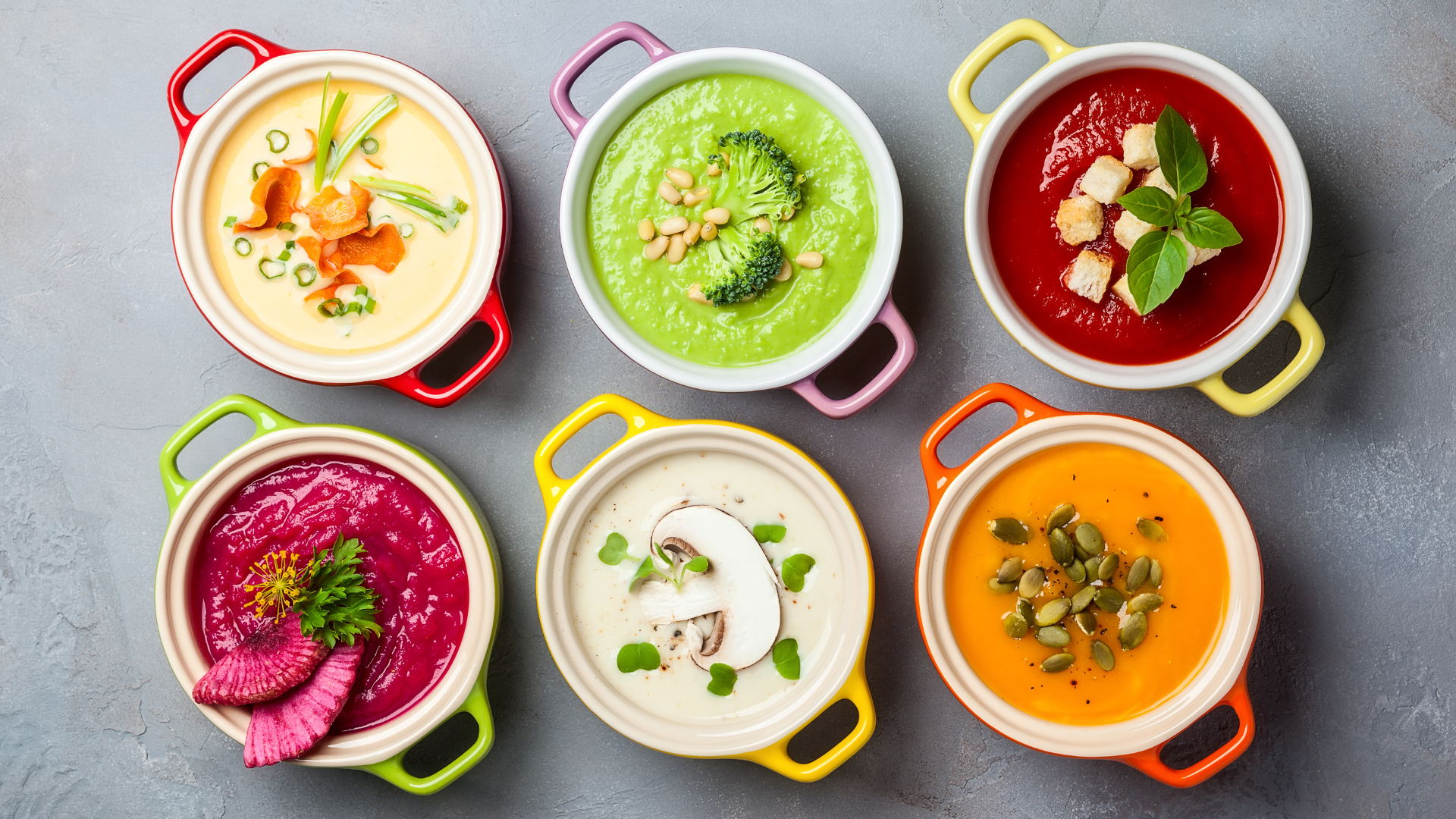
-
Here is a basic recipe for making velouté soup:
Ingredients:
4 tbsp butter
4 tbsp all-purpose flour
4 cups (1 liter) chicken, veal, or fish stock (depending on your preference)
1/2 cup heavy cream (optional, for extra richness)
Salt and white pepper to taste
Fresh herbs (e.g., parsley, chives) for garnish
Instructions:
Make the Roux:
In a medium saucepan, melt the butter over medium heat.
Once the butter is fully melted and slightly bubbling, add the flour.
Stir constantly with a whisk or wooden spoon, cooking for about 2 minutes until the flour loses its raw smell but doesn't take on color. This mixture is your roux.
Add the Stock:
Slowly add the stock to the roux, whisking continuously to avoid lumps.
Once all the stock is incorporated, bring the mixture to a simmer.
Simmer:
Let the soup simmer gently for about 20-30 minutes, stirring occasionally, until it thickens slightly and becomes smooth and velvety.
Finish with Cream (optional):
For extra richness, stir in the heavy cream. Let it heat through for a few minutes.
Season:
Taste the soup and adjust the seasoning with salt and white pepper.
Serve:
Ladle the soup into bowls and garnish with fresh herbs like chopped parsley or chives.
Regional Soups
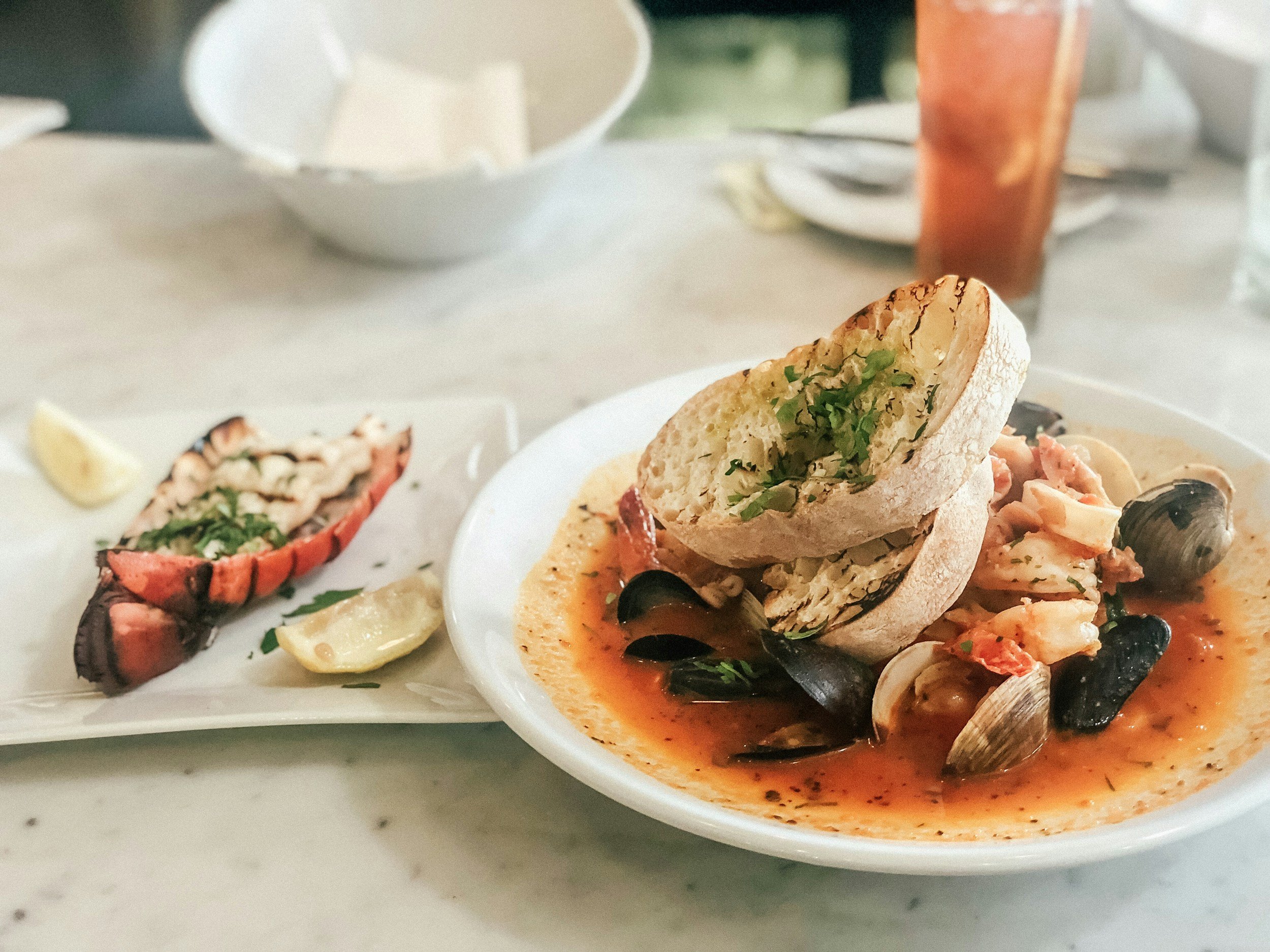
France’s varied landscapes and climates give rise to a wide array of regional soups, reflecting the unique agricultural products and cultural influences of each area:
Bouillabaisse (Provence): A fish stew (often referred to as a soup) from Marseille, packed with Mediterranean fish, shellfish, and flavored with herbs, saffron, and garlic. It's traditionally served with rouille and bread.
Soupe de Poisson (Coastal Regions): A traditional fish soup from the coastal regions, especially Brittany and Provence. Made with a variety of fish, it's often served with croutons, grated cheese, and rouille (a garlic mayonnaise).
Vichyssoise (Loire Valley): A cold potato and leek soup, traditionally served chilled and made with cream. It’s said to have been created by French chef Louis Diat while working in the United States, but its roots are French.
Tourin (Southwest France): A garlic-based soup thickened with eggs, popular in the Dordogne and Périgord regions. It's known for its rustic simplicity and depth of flavor.
Bouillabaisse
Bouillabaisse is a fish stew, though it is often referred to as a soup. The distinction lies in the cooking method and ingredients.
Traditionally from Marseille, France, bouillabaisse includes a variety of Mediterranean fish, shellfish, and sometimes vegetables like tomatoes, leeks, and fennel. The broth is flavorful, made from simmering fish bones, aromatic herbs, and saffron. It can be served with the seafood and vegetables in the stew or with a portion of the broth served separately as a soup.
So while it can seem soup-like, it is technically a stew because of the hearty seafood and vegetables.
Lobster Soup and Oyster Soup
Lobster Soup
Prepare the Lobster:
Boil a large lobster until fully cooked. Once cooled, extract all the meat from the shell, making sure to remove any cartilage. Set the lobster meat aside.
Prepare the Bread and Lobster Paste:
In a frying pan, melt butter and fry thin slices of bread until golden and crisp.
Using a marble mortar, place the fried bread slices and some lobster meat, pounding them alternately to form a smooth paste. Continue this process until all the lobster and bread have been combined into the paste.
Cook the Soup:
In a stewpan, melt additional butter and add the bread and lobster paste mixture. Stir to combine thoroughly.
Add a quart of boiling milk to the stewpan, seasoning with salt, mace, and nutmeg to taste.
Stew:
Let the mixture stew gently over low heat for about half an hour, allowing the flavors to meld and the soup to thicken slightly.
This rich, creamy lobster soup combines the sweetness of lobster with the smooth texture of the bread paste, balanced by subtle spices like mace and nutmeg for a truly luxurious dish.
Oyster Soup
Prepare the Oysters:
Take two quarts of fresh oysters and drain them, reserving the oyster liquor. Remove the tough parts of the oysters, keeping only the tender meat.
Prepare the Eggs and Oysters Paste:
Boil a dozen eggs until hard. Once peeled, cut the eggs into pieces. In a mortar, pound the boiled eggs and oysters together, alternating between them to create a smooth paste.
Boil the Liquor:
In a pot, bring the reserved oyster liquor to a boil. Add a head of celery, finely chopped, along with two grated nutmegs, a teaspoon of mace, a teaspoon of cloves, two teaspoons of salt, and a teaspoon of whole pepper. Allow the mixture to boil and infuse for a few minutes.
Combine and Cook:
Gradually stir in the pounded eggs and oysters into the boiling liquor. Add a little at a time to ensure even mixing.
Let the soup come to a gentle boil once more, allowing all the flavors to meld together.
Serve:
Once it has boiled and thickened slightly, remove the soup from heat and serve immediately.
Note: This recipe works best with fresh, unsalted oysters, as salt oysters are too briny for soup preparation. The combination of oysters, eggs, and spices creates a rich, flavorful dish with a unique texture and depth of flavor.

-
Here’s a classic French Lobster Soup recipe, often referred to as Bisque de Homard, which is a rich and creamy soup made with lobster and a blend of aromatic vegetables. This elegant soup is perfect for special occasions.
Ingredients:
2 live lobsters (about 1-1.5 lbs each)
4 tablespoons butter
1 onion, finely chopped
1 leek (white part only), finely chopped
2 carrots, chopped
2 celery stalks, chopped
3 garlic cloves, minced
2 tablespoons tomato paste
1 cup white wine
6 cups fish or vegetable stock
1 bay leaf
1 sprig thyme
1 teaspoon paprika
½ cup heavy cream
2 tablespoons brandy or cognac (optional)
Salt and pepper, to taste
Fresh parsley or chives, for garnish
Instructions:
Cook the Lobster:
Bring a large pot of salted water to a boil. Add the live lobsters and cook for about 8-10 minutes until they turn bright red. Remove the lobsters and allow them to cool slightly.
Extract the lobster meat from the shells. Set the meat aside and reserve the shells for the soup base. Roughly chop the lobster meat.
Sauté the Vegetables:
In a large soup pot, melt the butter over medium heat. Add the chopped onion, leek, carrots, celery, and garlic. Cook for 7-8 minutes, stirring occasionally, until the vegetables are softened and fragrant.
Add the Lobster Shells and Tomato Paste:
Add the lobster shells to the pot with the vegetables. Stir in the tomato paste and cook for 3-4 minutes, allowing the tomato paste to caramelize slightly.
Deglaze with Wine:
Pour in the white wine, and stir to deglaze the pot, scraping up any browned bits from the bottom. Let it simmer for 2-3 minutes to cook off the alcohol.
Add Stock and Simmer:
Add the fish or vegetable stock, bay leaf, thyme, and paprika. Bring the mixture to a boil, then reduce the heat and simmer for 30 minutes, allowing the flavors to develop.
Strain the Soup:
After simmering, remove the lobster shells, bay leaf, and thyme sprig. Use a fine mesh strainer or cheesecloth to strain the soup, pressing down on the solids to extract as much liquid as possible. Return the strained liquid to the pot.
Blend and Add Cream:
For a smoother texture, you can blend the soup using an immersion blender or in a regular blender (in batches). Stir in the heavy cream and bring the soup back to a gentle simmer. For added richness, you can stir in the brandy or cognac at this stage.
Add the Lobster Meat:
Add the chopped lobster meat to the soup and cook for an additional 5 minutes, just to heat through. Season with salt and pepper to taste.
Serve:
Ladle the lobster soup into bowls, garnish with fresh parsley or chives, and serve hot.
Serving Suggestions:
Serve the soup with crusty French bread or croutons.
For a luxurious touch, drizzle a bit of extra cream on top or add a dash of brandy.
This French Lobster Soup is a rich, creamy, and flavorful bisque that highlights the sweet and delicate flavor of lobster, making it an impressive dish for dinner parties or special meals.
4o
-
Here’s a traditional recipe for French Oyster Soup (Soupe aux Huîtres), which is a luxurious and delicate dish often served in French cuisine. The briny flavor of the oysters is complemented by cream and subtle aromatics, creating a soup perfect for special occasions.
Ingredients:
2 dozen fresh oysters, shucked (reserve the oyster liquor)
4 tablespoons butter
1 small onion, finely chopped
1 leek (white part only), finely chopped
2 celery stalks, finely chopped
2 garlic cloves, minced
2 cups fish or vegetable stock
1 cup whole milk
1 cup heavy cream
1 bay leaf
1 teaspoon fresh thyme (or ½ teaspoon dried)
Salt and pepper, to taste
A pinch of cayenne pepper (optional)
Fresh parsley or chives, for garnish
Crusty bread or croutons, for serving
Instructions:
Prepare the Oysters:
If you're using fresh oysters, shuck them carefully and reserve the oyster liquor (the liquid inside the shell). Strain the liquor through a fine mesh sieve to remove any sand or grit. Set the oysters and liquor aside.
Sauté the Vegetables:
In a large soup pot, melt the butter over medium heat. Add the chopped onion, leek, celery, and garlic. Sauté for about 5-7 minutes, stirring occasionally, until the vegetables are softened and fragrant but not browned.
Add Stock and Herbs:
Pour in the fish or vegetable stock and the reserved oyster liquor. Add the bay leaf and thyme. Bring the mixture to a gentle boil, then reduce the heat and simmer for about 10-15 minutes to allow the flavors to meld.
Add the Milk and Cream:
Stir in the milk and heavy cream, and gently heat the soup. Do not bring it to a full boil, as this can cause the milk to curdle. Season with salt, pepper, and a pinch of cayenne pepper (if using) for a hint of spice.
Add the Oysters:
Once the soup is gently simmering, add the shucked oysters. Cook for about 3-5 minutes, just until the oysters are plump and their edges start to curl. Be careful not to overcook them, as oysters can become tough if cooked for too long.
Adjust Seasoning and Serve:
Taste the soup and adjust the seasoning with more salt and pepper, if needed. Remove the bay leaf before serving.
Garnish and Serve:
Ladle the oyster soup into bowls, and garnish with fresh parsley or chives. Serve hot with crusty bread or croutons for dipping.
Serving Suggestions:
This soup is often paired with a glass of crisp white wine or Champagne.
For a more elegant presentation, drizzle a bit of extra cream or add a touch of lemon zest just before serving.
This French Oyster Soup is creamy, rich, and full of the fresh, briny taste of oysters, making it a refined dish that’s perfect for an elegant dinner or special occasion.
French soup culture is a rich tapestry that blends simplicity with sophistication. Whether a humble bowl of garbure or an elegant consommé, soups in France showcase the country's dedication to balancing flavors, textures, and local ingredients. They remain a cornerstone of French dining, offering comfort, nourishment, and a deep connection to France's culinary heritage.













